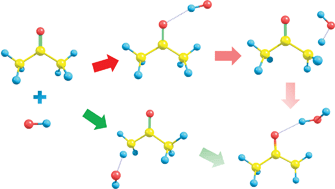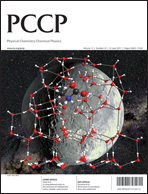A theoretical study is presented of the mechanism and kinetics of the reactions of the hydroxyl radical with three ketones: dimethyl (DMK), ethylmethyl (EMK) and iso-propylmethyl (iPMK) ketones. CCSD(T) values extrapolated to the basis set limit are used to benchmark the computationally less expensive methods G3 and G3MP2BH&H, for the DMK + ȮH reaction system. These latter methods are then used in computations involving the reactions of the larger ketones. All possible abstraction channels have been modeled. A stepwise mechanism involving the formation of a reactant complex in the entrance channel and a product complex in the exit channel has been recognized in part of the abstracting processes. High-pressure limit rate constants of the title reactions have been calculated in the temperature range of 500–2000 K using the Variflex code including Eckart tunneling corrections. Variable reaction coordinate transition state theory (VRC-TST) has been used for the rate constants of the barrier-less entrance channel. Calculated total rate constants (cm3 mol−1 s−1) are reported as follows:
k(DMK) = 1.32 × 102 × T3.30exp(503/T)
k(EMK) = 3.84 × 101 × T3.51exp(1515/T)
k(iPMK) = 2.08 × 101 × T3.58exp(2161/T)
Group rate constants (on a per H atom basis) for different carbon sites in title reactions have also been provided.

You have access to this article
 Please wait while we load your content...
Something went wrong. Try again?
Please wait while we load your content...
Something went wrong. Try again?


 Please wait while we load your content...
Please wait while we load your content...